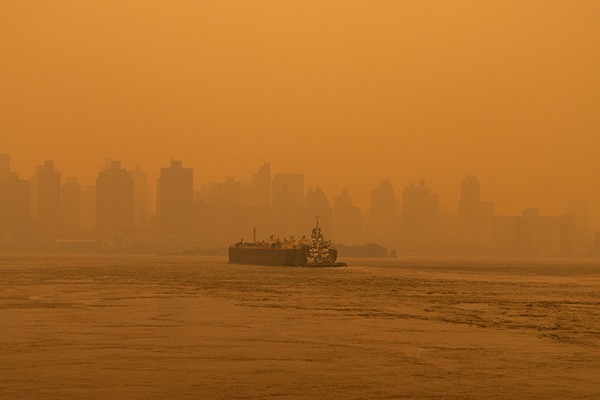



| By Dr. Ronald Hoffman

Recently, I read Hugh Howey’s epic science fiction trilogy “Silo”. So I was delighted to see it adapted as an Apple TV series, and began watching episodes.
It’s about a futuristic society that has sheltered underground for centuries in a huge silo after an unspecified calamity renders the surface uninhabitable. Exiling the occasional law-breaker through the airlock means a certain death sentence. A repressive government reminds the subterranean inhabitants that they’re lucky to be protected and they obediently hunker in safety. SPOILER ALERT: It’s a metaphor!
Life imitates art. I was reminded of Silo the other day when dire warnings were broadcast about an approaching plume of smoke from Canadian wildfires: “Avoid outdoor exertion. Wear a well-fitted N95 mask. If possible, shelter in place.” Familiar alerts that survivors of the pandemic have been conditioned to heed.
Skeptical at first, I went to work nonetheless, maskless. The air was hazy, with a peculiar yellow light. While it did smell smoky, the aroma was far less overwhelming than the scent of marijuana that daily hovers over every street corner in Manhattan.
I noted as I walked that many of my fellow New Yorkers had reflexively snapped back to 2020, re-donning masks.
Later, as I was seeing patients in my office, an announcement pealed over the PA system, ordinarily reserved for fire drills: “In view of the outdoor air conditions, we have taken the precaution of turning off the building’s ventilation system. Please stand by for further instructions.”
My patient and I were curious, so we proceeded to my exam room, which offers a splendid view of the southeast corner of Central Park and the Plaza Hotel. Indeed, the distant skyscrapers were partially obscured, shrouded in a brownish mist.
Minutes later, back in my office, I noticed the sky outside had darkened, equivalent to a winter twilight. Outside, the cars had their headlights on. Darkness at noon?
It lasted for a day, then dissipated. The next afternoon, the Yankees were playing a makeup doubleheader after a previous day’s cancellation for “smoke”—unprecedented in their over century-long reign.
Were the dire health warnings justified? Did masks do any good?
We’ve had bad air before in New York. Who can forget 9-11, when a terrible odor, like burned bandages, lingered for days over the city? But those fumes carried special hazards, comprised as they were of fine aerosolized concrete particles, laced with metals, plastic residues, chemicals, and asbestos. Their toxic legacy is evinced in the terrible toll on Ground Zero rescuers.
Indeed, wildfire smoke alone is hazardous to health. Those with respiratory conditions are particularly at risk. A recent survey from Australia, where wildfires raged, showed a high incidence of exacerbations of asthma, with a sharp rise in drug prescriptions and hospitalizations.
Acute exposure over a few days can be problematic, but I grew up in LA, where smog alerts were routine. I can remember my lungs hurting after a hard day at play. It’s chronic exposure that’s most harmful.
Authorities said that spending a day outside in New York during the height of the smoke emergency was equivalent to smoking 6 cigarettes a day. Alas, that was my intake on a good day during college, when I routinely puffed on Pall Malls. Unlike me, tens of millions didn’t quit in their 20s, and continue to inhale burning plant matter laced with chemical additives for decades.
Then there are those who smoke pot or vape. This entails deliberately toking on super-heated fumes, and then holding one’s breath to facilitate uptake.
Consider, too, our Paleolithic ancestors, crouching in caves seeking shelter from wild animals, marauding foes, or encroaching Ice Age glaciers. The invention of fire provided respite, but poor ventilation inevitably continually assaulted early man’s lungs.
For some contemporary people, the situation is not too different. Not everyone has access to hot water, efficient furnaces, electric heaters or gas or electric cooking stoves. The World Health Organization estimates that household air pollution—due to fires or inefficient stoves fueled by kerosene, wood, crop waste, peat, and even animal dung—afflicts one third of the world’s population, around 2.4 billion people.
The WHO asserts smoky indoor air with poor ventilation is responsible for 3.2 million deaths per year, including 237,000 deaths among children under five (women and children, who reside at home and tend fires and stoves, are disproportionately affected).
While lung cancer, chronic obstructive pulmonary disease and asthma accounted for nearly half of the estimated deaths, there was a surprising toll from circulatory diseases; 32% were from premature heart disease, 23% from strokes. Studies have confirmed that exposure to microscopic particulate matter, which readily enters the blood vessels via the lungs, can literally curdle the blood, resulting in life-threatening clots. Heart attacks definitely increase on smog alert days, and people who live near busy roadways experience more major coronary events.
Are masks effective against smoke? The people wearing paper and cloth masks on Manhattan streets were in a fool’s paradise; airborne smoke particles, like viruses, are too small to be captured by thin porous mesh-like barriers. Double or triple masking might make sense, although unconfirmed by studies. N95 or KN95 respiratory masks might perform better, and authorities recommended them to the vulnerable during the smoke emergency, but they need to be fitted properly, which is seldom the case with casual use. And they’re a nuisance to wear for long periods, or with even minor exertion. Nevertheless, unlike during Covid, where outdoor transmission was negligible and masking worthless, wearing high-quality masks outdoors on smoky days merits at least some consideration. This one time, I spared masked passersby my scorn.
Are there nutrients that can counteract the effects of wildfire smoke? That’s unclear, and I could find no studies to substantiate their use. But since smoke particles cause their harm via free radicals and inflammation, it might make sense to take antioxidants and anti-inflammatories. Supplements like C, E, zinc, selenium and NAC or glutathione might fit the bill, as do fish oil, curcumin and quercetin. Circulatory enhancers like pycnogenol and ginkgo might play a protective role, as might beet-derived dietary nitrates.
A word about contemporary wildfires. While many blame these disasters on climate change, reinforcing a popular narrative of human-driven planetary immolation, there’s ample evidence that they’ve been a feature of terrestrial life since time immemorial. Lightning strikes ignited blazes well before the advent of careless campers, arsonists and malfunctioning power lines. Conifers like pines long ago evolved methods to propagate after natural forest fires; During the blaze, intense heat causes pinecones to release fire-resistant seeds, popcorn-like, to arise later amid ashes as fresh seedlings, allowing for better dispersal.
We have an overly romanticized conception of what constitutes a “virgin” forest. Settlers encountered vast tracts of thick, impenetrable woodlands during Colonial times—the “forest primeval”. They then sawed, hacked and plowed their way through trees and underbrush to establish farms. They propagated the myth that they were taming original pristine wilds.
But earlier explorers who first encountered native Americans centuries before noted something different. Tribes had for centuries engaged in forest management, leveraging controlled burning and selective culling of trees to establish manageable hunting preserves and agricultural plots. Theirs was a harmonious, deliberately-cultivated ecosystem, less prone to conflagrations.
Soon after, stable pre-Colombian cultures disintegrated in the wake of European encroachment that brought diseases that decimated the Native American population with measles, smallpox and venereal disease. The original inhabitants’ elaborate system of forestry management collapsed, and seemingly “virgin” forests reappeared, the result of neglect.
Fast-forward to the present, when well-intended but misguided theories of nature preservation have led to hands-off-at-all-costs policies of forest management. An overabundance of combustible plant fuel in proximity to rapidly-expanding human populations has hiked the risk of catastrophic fires. Have wildfires ever ravaged well-manicured Central Park?
Maybe it’s time to emulate our ancestors to avoid future calamities—anomalous events like those of last week highlight our vulnerability.
Though we think of declining estrogen as the hallmark of menopause, it's actually common for…

Up to 12 percent of Americans have ulcers at some point in life. Peptic ulcers…
Gallbladder disease is a modern illness. An estimated 20 million Americans have gallbladder disease. The…

We’re living longer, but cognitive decline threatens to rob us of quality of life in…

Dr. Antonio Bianco, recipient of the American Thyroid Association’s John B. Stanbury Thyroid Pathophysiology Medal,…

There’s a misconception among low-carb dieters. Many people believe a low-carb diet is much higher…

Leyla Weighs In: Eating for Energy and Emotional Well-Being

Our virtual voicemail is open 24/7, so there's no need to wait to submit your questions for Dr. Hoffman. Leave a message, and you may hear your question featured on the Intelligent Medicine radio program!